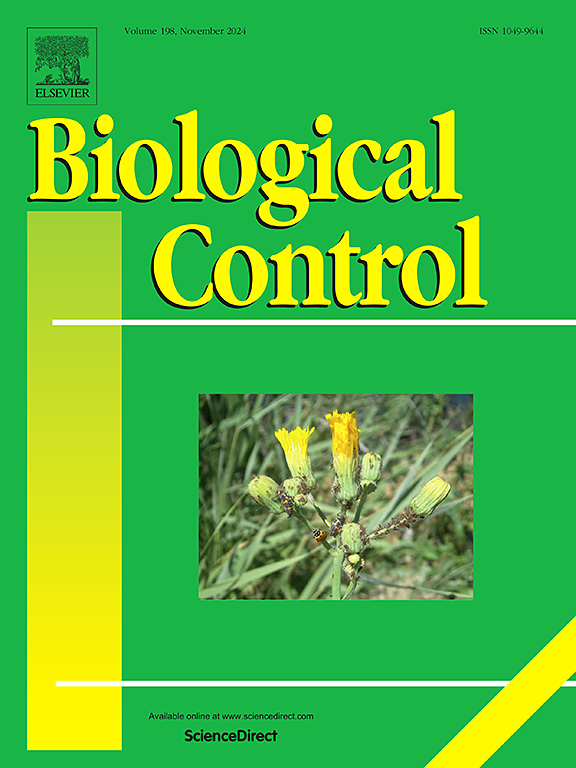幼林人工林蜘蛛的性状多样性和群落组成与低食草性有关
IF 3.7
2区 农林科学
Q2 BIOTECHNOLOGY & APPLIED MICROBIOLOGY
引用次数: 0
摘要
蜘蛛是森林生态系统中数量占主导地位的多面手捕食者,但其在人工林中的生物防治作用尚不清楚。蜘蛛的生物防治潜力可能取决于害虫类型、森林类型、季节、性状组成和蜘蛛群落多样性之间的相互作用。使用相关的方法,我们解决了在幼龄(10-15年)橡木(栎属)和白蜡(白蜡属)人工林的这一知识差距。我们在春末和秋末采集了103个叶栖节肢动物和叶片。然后,我们测量了蜘蛛的性状(体型和狩猎策略),并检查了两个食草性指标(叶片损伤和叶片干生物量)。在两个季节,半翅目昆虫的丰度与蜘蛛的功能多样性呈显著负相关。晚春幼虫丰度与伏击蛛丰度呈负相关,与圆网蛛丰度呈微相关。草食性鞘翅目的丰度与秋季蜘蛛的功能均匀度呈负相关。草食性与蜘蛛的空间网构造丰度和功能多样性在春季呈负相关,与蜘蛛的平均体型在秋季呈负相关。在灰分人工林中,秋季蜘蛛丰度与草食度呈负相关。我们的研究结果提供了间接证据,证明栖息在叶子上的蜘蛛可以用于森林害虫的生物控制。蜘蛛的生物防治潜力似乎取决于功能多样性和同一性。因此,森林害虫治理不仅要关注蜘蛛的群落组成,还要关注蜘蛛的功能性状多样性。本文章由计算机程序翻译,如有差异,请以英文原文为准。
Trait diversity and spider community composition are associated with lower herbivory in young forest plantations
Spiders constitute a numerically dominant group of generalist predators in forest ecosystems, but their biocontrol function in forest plantations is not well understood. The biocontrol potential of spiders may depend upon interaction among pest type, forest type, season, trait composition, and spider community diversity. Using a correlative approach, we addressed this gap in knowledge in young (10–15 years) oak (Quercus spp.) and ash (Fraxinus spp.) forest plantations. We sampled (N = 103 samples) foliage-dwelling arthropods and leaves during late spring and autumn. We then measured traits of spiders (body size and hunting strategy) and examined two indicators of herbivory (leaf damage and leaf dry biomass). In oak plantations, abundances of Hemiptera negatively correlated with functional diversity of spiders consistently during the two seasons. Abundances of caterpillars negatively correlated with abundances of ambushers and marginally with abundances of orb-web building spiders during late spring. Abundances of herbivorous Coleoptera negatively correlated with functional evenness of spiders in autumn. Moreover, herbivory negatively correlated with abundances of Space-web builders and functional diversity of spiders in spring but with mean spider body size in autumn. In ash plantations, herbivory negatively correlated with spider abundances in autumn. Our findings provide indirect evidence that foliage-dwelling spiders can be useful for the biological control of forest pests. The biocontrol potential of spiders seems to depend on both functional diversity and identity. Therefore, forest pest management should focus not only on spider community composition but also functional trait diversity of spiders.
求助全文
通过发布文献求助,成功后即可免费获取论文全文。
去求助
来源期刊

Biological Control
生物-昆虫学
CiteScore
7.40
自引率
7.10%
发文量
220
审稿时长
63 days
期刊介绍:
Biological control is an environmentally sound and effective means of reducing or mitigating pests and pest effects through the use of natural enemies. The aim of Biological Control is to promote this science and technology through publication of original research articles and reviews of research and theory. The journal devotes a section to reports on biotechnologies dealing with the elucidation and use of genes or gene products for the enhancement of biological control agents.
The journal encompasses biological control of viral, microbial, nematode, insect, mite, weed, and vertebrate pests in agriculture, aquatic, forest, natural resource, stored product, and urban environments. Biological control of arthropod pests of human and domestic animals is also included. Ecological, molecular, and biotechnological approaches to the understanding of biological control are welcome.
 求助内容:
求助内容: 应助结果提醒方式:
应助结果提醒方式:


